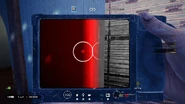The Heartbeat Sensor is a gadget featured in several installments in the Tom Clancy's Rainbow Six Franchise.
Early Games[]
The Heartbeat Sensor is a gadget featured in Tom Clancy's Rainbow Six. It returns unchanged in Tom Clancy's Rainbow Six: Rogue Spear and Tom Clancy's Rainbow Six: Take-Down – Missions in Korea.
The Heartbeat Sensor is capable of tracking human heartbeat even through thick layers of concrete. It works by detecting the characteristic ultra-low-frequency electric field given off by a beating heart. In passive mode it scans a small full circle around the user; when the trigger is pulled it scans a larger cone straight ahead.
| ||||||||||||||
| ||||||||||||||||||||||||||
| ||||||||||||||||||||
Raven Shield[]
The Heartbeat Sensor is a gadget featured in Tom Clancy's Rainbow Six 3: Raven Shield.
The Heartbeat Sensor is capable of tracking a human heartbeat even through thick layers of concrete. It works by detecting the characteristic ultra-low-frequency electric field given off by a beating heart. When in use, the heartbeat sensor scans for heartbeats in a cone straight ahead and displays targets as pulsing circles. It does not, however, differentiate between friends and foes.
The False Heartbeat Puck, Heartbeat Sensor Jammer, and SAHB Sensor Jammer can be used as a counter for the Heartbeat Sensor.
| |||||||||||||||||||||||||||||
Siege[]
The HB-5 Cardiac Sensor, also known as the Heartbeat Sensor is a gadget featured in Tom Clancy's Rainbow Six Siege. It is a unique gadget available to Pulse. The gadget functions in a similar manner to past installments, allowing players to detect the heartbeats of nearby enemies through obstacles.
Overview[]
The Heartbeat Sensor creates scan lines from left to right, highlighting Attacker hearts in proximity every time the scan lines pass through them, even through walls.
An Attacker's heart is shown by a red dot on the Heartbeat Sensor and a white circle is shown around it. Normal Attackers can be detected by the Heartbeat Sensor from a maximum of 9 meters away. Attackers boosted by Finka's Adrenal Surge can be detected by the Heartbeat Sensor up to 14 meters away.
Every time the Heartbeat Sensor detects an Attacker, it beeps once. The beeping sound that the Heartbeat Sensor emits gets louder as the proximity between Pulse and his target gets closer. When targets get closer the red dot will grow larger in low proximity. Enemies will not be able to hear the beeping from the Heartbeat Sensor, but will be able to hear Pulse taking out and putting away the Heartbeat Sensor. This however, is fairly difficult since the noise made is quite low.
The Heartbeat Sensor can scan directly through walls and floors. No matter how many obstacles are in its way it will scan a target within 9 meters. The Heartbeat Sensor is viable for vertical play (i.e. Defuser plant denial). The Heartbeat Sensor becomes more useful when used vertically than horizontally. Paired with a Nitro Cell, Pulse becomes a formidable force as he can scan for enemies through walls and effectively take them out.
Counters[]
The Heartbeat Sensor is an electronic gadget, making it vulnerable to a number of Attacker gadgets:
- IQ can easily locate and eliminate Pulse through walls by detecting Pulse's Heartbeat Sensor when it is being used.
- Twitch's Shock Drone can temporarily disable the Heartbeat Sensor if Pulse was shocked while using it.
- Thatcher's EMP Grenades will temporarily disable the Heartbeat Sensor for 5 seconds if Pulse is in range of the EMP blast.
Gallery[]
Extraction[]
The Heartbeat Sensor returns in Tom Clancy's Rainbow Six Extraction as the HB-7 Cardiac Sensor. It remains a unique gadget exclusive to Pulse.
Overview[]
The Heartbeat Sensor detects nearby Nests, REACT Scientists, and MIA Operators through obstacles. It does this by creating scan lines from left to right, highlighting those affected in proximity every time the scan lines pass through them. This means the Heartbeat Sensor can scan directly through walls and floors. No matter how many obstacles are in its way it will scan a target within its proximity.
Highlights are shown by a red dot on the Heartbeat Sensor and a white circle is shown around it. Every time the Heartbeat Sensor detects a target, it beeps once. The beeping sound that the Heartbeat Sensor emits gets louder as the proximity between Pulse and his target gets closer. When targets get closer the red dot will grow larger in low proximity.
Detected Nests and REACT personnel will be displayed to the rest of the team as a red dot with a white circle, and can be pinged - this is not a Scan, but it does allow allies to have some guidance on where Nests are.
At Operator level 2, the Heartbeat Sensor's detection range is increased to 40 meters. At Operator level 7, it will automatically detect Nests within 8 meters when the sensor is holstered. Finally at Operator level 10, teammates within 10 meters have their speed increased to four when the sensor is active. When holstered, it will now scan detected enemies.
Gallery[]
| |||||||||||||||||||||||||||||
Trivia[]
- In reality, this technology (detecting the ultra low frequency electromagnetic field given of the human heart) is theoretically impossible to develop for two reasons:
- The receiving antenna on the device would have to have a size of the same order of magnitude as the wavelength of the ULF emitted by the heart (thousands km). Any practical antenna would have extremely low sensitivity and not detect anything due to thermal noise and other factors
- Unless the antenna would be tens of thousand km wide, there would be absolutely no possibility of detecting the direction of arrival of the signal (Abbe diffraction limit law). for the same reason the heart of the person carrying the device would always show up in the system, and the device would not be able to tell the direction of the signal.
- Other technologies (Doppler shift of active radars) are possible, though they would require either a very stable radar platform or very advanced processing. The radar waves would also appear to anyone with a receiver.





